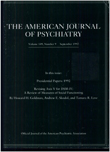A family-genetic study of girls with DSM-III attention deficit disorder
Abstract
OBJECTIVE: The authors evaluated family-genetic risk factors in girls with attention deficit disorder and compared these results to findings in the authors' previous study of boys with attention deficit disorder. METHOD: Twenty-one girls with attention deficit disorder and 20 normal comparison girls were consecutively ascertained from a pool of existing and new referrals from a pediatric psychopharmacology unit and a medical pediatric unit of the same urban hospital. First-degree relatives of the attention deficit disordered girls (N = 69) and of the normal girls (N = 71) were also assessed. Both groups of girls and their relatives were evaluated on the basis of structured diagnostic interviews conducted by raters who were blind to the clinical status of the probands. RESULTS: The relatives of the girls with attention deficit disorder had higher risks for attention deficit disorder, antisocial disorders, major depression, and anxiety disorders. The higher risk for attention deficit disorder could not be accounted for by gender or generation of relative, age of proband, social class, or family intactness. These findings are highly consistent with the findings in the authors' previous study of boys with attention deficit disorder, which was conducted with identical methods. CONCLUSIONS: This study provides further support for the validity of the diagnosis of attention deficit disorder in girls and suggests that the genders share a common biological substrate.
Access content
To read the fulltext, please use one of the options below to sign in or purchase access.- Personal login
- Institutional Login
- Sign in via OpenAthens
- Register for access
-
Please login/register if you wish to pair your device and check access availability.
Not a subscriber?
PsychiatryOnline subscription options offer access to the DSM-5 library, books, journals, CME, and patient resources. This all-in-one virtual library provides psychiatrists and mental health professionals with key resources for diagnosis, treatment, research, and professional development.
Need more help? PsychiatryOnline Customer Service may be reached by emailing [email protected] or by calling 800-368-5777 (in the U.S.) or 703-907-7322 (outside the U.S.).



